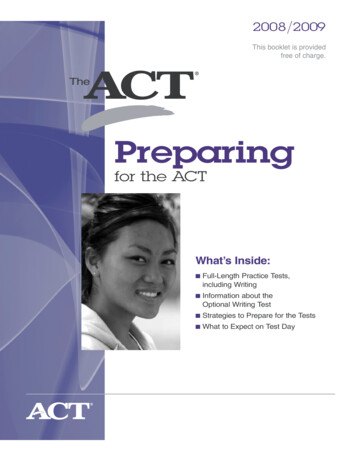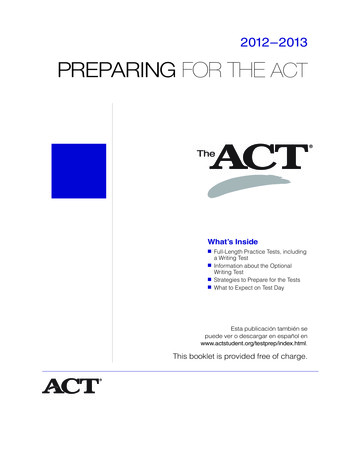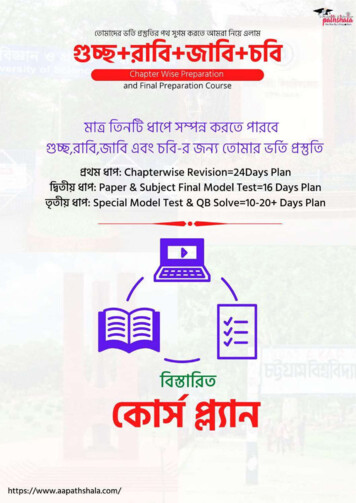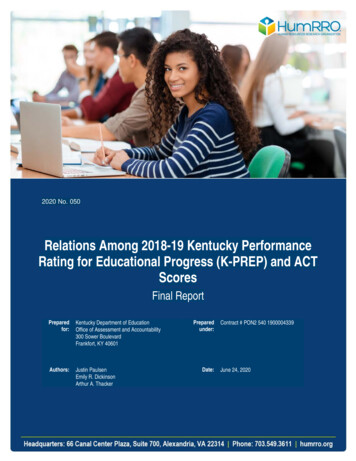
Transcription
2008 /2009This booklet is providedfree of charge.Preparingfor the ACTWhat’s Inside: Full-Length Practice Tests,including Writing Information about theOptional Writing Test Strategies to Prepare for the Tests What to Expect on Test Day
Contents1.2.3.4.Additional ACTPreparation Materials General Preparation for the ACT Tests . . . . . . . . . . . . 2Strategies for Taking the ACT Tests . . . . . . . . . . . . . . . 5What to Expect on Test Day . . . . . . . . . . . . . . . . . . . . 11Taking the Practice Tests . . . . . . . . . . . . . . . . . . . . . . 12Practice Multiple-Choice Tests . . . . . . . . . . . . . . . 13Practice Writing Test . . . . . . . . . . . . . . . . . . . . . . . 575. Scoring Your Tests . . . . . . . . . . . . . . . . . . . . . . . . . . . 59How to Score the Multiple-Choice Tests. . . . . . . . 59How to Score the Writing Test. . . . . . . . . . . . . . . . 676. Sample Answer Document . . . . . . . . . . . . . . . . . . . . . 73Multiple-Choice Tests . . . . . . . . . . . . . . . . . . . . . . 73Writing Test . . . . . . . . . . . . . . . . . . . . . . . . . . . . . . 75 ACT Online Prep : The only online test preparationprogram designed exclusively by ACT testdevelopment professionals. ACT Online Prep haspractice test questions, a practice essay with real-timescoring, a diagnostic test, and a personalized StudyPath. You can access ACT Online Prep viathe Internet anywhere and at any time. Order atwww.actonlineprep.com.The Real ACT Prep Guide is the official print guideto the ACT. This book includes three practice testspreviously used in actual administrations—eachwith an optional Writing Test, with explanations forall right and wrong answer choices. Order atwww.actstudent.org.General Preparationfor the ACT Tests1A Message to StudentsThis booklet, which is provided free of charge, is intendedto help you do your best on the ACT. It summarizes generaltest-taking strategies, describes the content of each test,provides specific tips for each, and lets you know what toexpect on test day. Included in this booklet are completepractice tests—“retired” ACT questions that wereadministered to students on a national test date, includinga writing prompt—a sample answer document, and selfscoring instructions. Choosing a Test OptionStudents may register for one of two Test Options: theACT (No Writing) or the ACT Plus Writing, which includesa 30-minute Writing Test, and has a higher fee. The ACTWriting Test complements the ACT English Test. Thecombined results from both tests provide information aboutyour understanding of the conventions of standard writtenEnglish and your ability to produce a direct sample of yourwriting. Taking the ACT Plus Writing will provide you withtwo additional scores: a Writing subscore and a CombinedEnglish/Writing score. Taking the ACT Writing Test does notaffect your subject area scores or your Composite score.Read this booklet carefully and take the practice tests wellbefore test day so you will be familiar with the tests, whatthey measure, and the strategies you can use to do yourbest on test day.Not all colleges require or recommend taking the ACTWriting Test. Check directly with the colleges you areconsidering to find out their requirements, or ask your highschool counselor which Test Option you should take. Youcan also check www.actstudent.org for a list of collegesthat have provided information to us about their policies—whether they require, recommend, or do not need resultsfrom the ACT Writing Test. Consult this list before youregister, so you will know which Test Option to select.ACT is committed to representing the diversity of oursociety in all its aspects, including race, ethnicity, andgender. Thus, test passages, questions, and writingprompts are deliberately chosen to reflect the range ofcultures in our population.We also are committed to ensuring that test questions andwriting prompts are fair—that they do not disadvantageany particular group of examinees. Extensive reviews ofthe fairness of test materials are rigorously conducted byboth ACT staff and external consultants. We also employstatistical procedures to help ensure that our test materialsdo not unfairly affect the performance of any group.The ACT Plus Writing is available within the United States,U.S. territories, and Canada on all established test datesand for Special and Arranged Testing during designatedtesting windows. The ACT Plus Writing is availableinternationally only in October, December, and April.ACT endorses the Code of Fair Testing Practices in Education and the Code ofProfessional Responsibilities in Educational Measurement, guides to the conductof those involved in educational testing. ACT is committed to ensuring that eachof its testing programs upholds the guidelines in each Code. A copy of each Codemay be obtained free of charge from ACT Customer Services (68), P.O. Box1008, Iowa City, IA 52243-1008, 319/337-1429. 2008 by ACT, Inc. All rights reserved.NOTE: This booklet is covered by federal copyright laws that prohibit thereproduction of the test questions without the express, written permission ofACT, Inc.2
Read each question carefully.It is important that you understand what each questionasks. Some questions will require you to go throughseveral steps to find the correct or best answer, whileothers can be answered more quickly.Choosing a Test DateBefore you choose a test date, check the applicationdeadlines of the colleges and scholarship agencies youare considering. It will normally take three to eight weeksafter a test date for ACT to mail your score report to youand to your college or scholarship choices.Answer the easy questions first.The best strategy for taking the tests is to answer the easyquestions and skip the questions you find difficult. Afteranswering all of the easy questions, go back and answerthe more difficult questions.Many colleges and scholarship agencies recommend thatstudents take the ACT during the spring of their junior year.By this time, students typically have completed most of thecoursework covered by the ACT. There are a number ofadvantages in taking the ACT then: You will receive test scores and other information thatwill help you plan your senior year of high school. Many colleges begin contacting prospective studentsduring the summer before their senior year. If you do not score as well as you believe you can,there will be opportunities to retake the ACT in the fallof your senior year and still have your new scoresavailable in time to meet admission and scholarshipdeadlines.Use logic on more difficult questions.When you return to the more difficult questions, try touse logic to eliminate incorrect answers to a question.Compare the answer choices to each other and note howthey differ. Such differences may provide clues as to whatthe question requires. Eliminate as many incorrect answersas you can, then make an educated guess from theremaining answers.General Test-TakingStrategies for the ACTAnswer every question.Your score on the tests will be based only on the numberof questions that you answer correctly; there is no penaltyfor guessing. Thus, you should answer every questionwithin the time allowed for each test, even if you have toguess. Your supervisor will announce when you have fiveminutes remaining on each test.The ACT contains multiple-choice tests in four areas:English, Mathematics, Reading, and Science. Each ofthese tests contains questions that offer either four or fiveanswer choices from which you are to choose the correct,or best, answer. The following suggestions apply to allfour tests:Review your work.If there is time left after you have answered every question ina test, go back and check your work on that test. Check tobe sure that you marked only one response to each question.You will not be allowed to go back to any other test or markreponses to a test after time has been called on that test.Pace yourself.The time limits set for each test give nearly everyoneenough time to finish all the questions. However, becausethe English, Reading, and Science Tests contain aconsiderable amount of text, it is important to pace yourselfso you will not spend too much time on one passage.Similarly, try not to spend too much time puzzling over ananswer to a specific problem in the Mathematics Test. Goon to the other questions and come back if there is time.Your supervisor will announce when you have five minutesremaining on each test.Be precise in marking your answer document.Be sure that you fill in the correct ovals on your answerdocument. Check to be sure that the number of the line ofovals on your answer document is the same as the numberof the question you are answering and that you mark onlyone response for each question.NOTE: You cannot plan on receiving your scores fromone test date in time to register for the next.Erase completely.If you want to change a multiple-choice answer, be sure touse a soft eraser that will not leave smudges and erase theunintended mark completely. Do not cross out answers oruse correction fluid or tape; you must erase. Correctionfluid/tape, smudges, or unintended marks may causeerrors in scoring.Read the directions for each test carefully.Before you begin taking one of the tests, read thedirections carefully. The English, Reading, and ScienceTests ask for the “best” answer. Do not respond as soon asyou identify a correct answer. Read and consider all of theanswer choices and choose the answer that best respondsto the question.To students approved to test at national test centerswith extended time:You will be allowed up to 5 hours total to work on themultiple-choice tests at your own pace, including breaksbetween tests. If you are taking the ACT Plus Writing,you will be allowed up to 5 hours and 45 minutes total.You will need to pace yourself through each test inorder to complete all tests within the total time allowed.Your supervisor will provide time updates every hour.When you complete each test, you must notify yoursupervisor that you are ready to begin the next test.The Mathematics Test asks for the “correct” answer. Readeach question carefully to make sure you understand thetype of answer required. Then, you may want to work outthe answer you feel is correct and look for it among thechoices given. If your answer is not among the choicesprovided, reread the question and consider all of theanswer choices.3
General Test-Taking Strategiesfor the ACT Writing TestPreparing for Test DayAlthough what you know will determine how well you do onthe ACT, your attitudes, emotions, and physical state mayalso influence your performance. The following tips willhelp you do your best: Be confident in your ability to do well on the ACT. Youcan do well! Be prepared to work hard. Know what to expect on test day. Familiarize yourselfwith the information in this booklet, and atwww.actstudent.org.NOTE: Most procedures in this booklet refer to testingon an established ACT test date at an ACT test center.Procedures may differ slightly if you test at anotherlocation. For example, for most administrations, youwon’t normally be allowed to use scratch paperbecause each page of the Mathematics Test has ablank column that you can use for scratch work. Take the practice tests in the exact order they arepresented. Review your responses so you will feelcomfortable about the approaching test day. Prepare well in advance for the tests. Do not leavepreparation to the last minute. Get plenty of rest the night before the tests so you willbe in good physical condition for taking them. Bring the following items with you to the test center:1. Your test center admission ticket (if you aretesting on an established ACT test date).2. Acceptable identification. Your admission ticket isnot identification. See details on your admissionticket or at www.actstudent.org. If you do notpresent acceptable identification at the time ofcheck-in, you will not be admitted to test (you willthen have to pay a Test Date Change fee totransfer your registration to a different test date).If you have any questions about acceptable ID,call ACT Test Administration (319/337-1510)before test day.3. Sharpened soft lead No. 2 pencils with gooderasers (no mechanical pencils; no ink, ballpoint,or felt-tip pens). Do not bring highlight pens orany other writing instruments; you will not beallowed to use them. If you have registered to takethe ACT Plus Writing, your essay must also becompleted with a soft lead No. 2 pencil.4. A watch to pace yourself. Do not bring a watchwith an alarm function. You will not be allowed toset an alarm because it will disturb other students.If your alarm sounds during testing, you will bedismissed and your answer document will not bescored. Your supervisor will announce when youhave five minutes remaining on each test.5. A permitted calculator for the Mathematics Test,if you wish to use one. (See shaded section onpage 5.)The ACT Writing Test lets you show your skill in planningand composing a short essay. It measures writingproficiencies that are taught in high school and areimportant for readiness to succeed in entry-level collegecomposition courses.The following general strategies will help if you take theACT Writing Test.Pace yourself.You will have 30 minutes to write your essay. It is importantto pace yourself in the way that best suits your personalwriting strategy. Many writers do best when they spendpart of their time planning their essay, most of their timewriting the essay, and the last part of their time reviewingthe essay to make corrections and small revisions. Thereis no formula for the best proportion of time to spendplanning, writing, and reviewing: writers, topics, andoccasions differ too widely for a universal rule to apply.Keep in mind, however, that you are unlikely to have timeto draft, revise, and recopy your essay. Therefore, taking afew minutes to plan your essay is a much better strategythan writing a first draft with the intent to copy it over for thefinal essay.In general, budget your time in the way that feels best toyou based on your experience in taking essay tests inschool and in other circumstances when you’ve donewriting within a time limit. Your supervisor will announcewhen you have five minutes remaining on the Writing Test.Read the directions carefully.Before you begin the Writing Test, read the directionscarefully. They tell you the aspects of writing on which youressay will be evaluated and give instructions on how towrite your essay in the answer folder.Read the writing prompt carefully.It is important that you understand exactly what the writingprompt asks you to do. A firm grasp of the assignment isas crucial for the ACT Writing Test as it is for writing essaysfor class. Be sure you have a clear understanding of theissue in the writing prompt and of the question you mustrespond to before you start to plan and write your essay.Write (or print) legibly in the answer folder.If your readers cannot make out what you have written,they cannot appreciate what you have said, and they willnot be able to score your essay. You may write or printyour essay, whichever you prefer—but you must do soclearly. You must write your essay using a soft lead No. 2pencil (not a mechanical pencil or ink pen) and only on thelined pages in the answer folder. You may not need all thelined pages, but to ensure you have enough room to finish,do not skip lines.Make corrections clear.If you make corrections by using erasures or cross-outs,do so thoroughly and legibly. You may write corrections oradditions neatly between the lines of your essay, but do notwrite in the margins of the lined pages.4
For students testing on established ACT test dates: If you register online, print your ticket from your ACT Webaccount. If you submit a registration folder, look for youradmission ticket in the mail about 2 weeks later. If you misplace your admission ticket or have notreceived it by 10 days before the test date, log in toyour ACT Web account to print a copy, or call ACTRegistration at 319/337-1270 for assistance. Check your admission ticket for your Test Option andthe location of the test center to which you have beenassigned. Pay attention to any special messages onyour ticket such as what building to go to, whatentrance to use, where to park, etc. If you areunfamiliar with the location, do a practice run to seehow to get there and how much travel time you willneed to arrive on time. Plan to arrive by the time listed on your admissionticket. If you arrive earlier than 7:45 a.m., you willprobably have to wait outside until testing personnelhave completed their arrangements. Be prepared for testing to start after all examineespresent at 8:00 a.m. have been checked in and seated. Dress comfortably. To conserve energy, your testcenter may be considerably warmer or cooler onweekends than during the week. Please dress so thatyou will be comfortable in a variety of temperatures.2Strategies for Takingthe ACT TestsThe ACT measures the knowledge, understanding, andskills that you have acquired throughout your education.Although the sum total of what a person has learned cannoteasily be changed, your performance in a specific area canbe affected by adequate preparation, especially if it hasbeen some time since you have taken a course in that area.There are three strategies that can help you to prepareyourself for the content included in the ACT:Familiarize yourself with the content of the ACT tests.Review the information about the tests that is provided onthe following pages. Note which content areas make up alarge proportion of the tests and which do not. The specifictopics included in each content area are examples ofpossible topics; they do not include all of the possibilities.Refresh your knowledge and skills in the content areas.Review those content areas you have studied but are notfresh in your mind. Spend your time refreshing yourknowledge and skills in the content areas that make uplarge portions of the tests.Use of Calculators on the ACT Mathematics Test It is your responsibility to bring a permitted calculator. Weregularly update information about which calculators areprohibited. To be certain your calculator will be permittedon test day, visit www.actstudent.org or call 800/498-6481for a recorded message. If you use a prohibited calculator,you will be dismissed and your answer document will notbe scored. calculators built into cell phones or any other electroniccommunication devicescalculators with a typewriter keypad (letter keys inQWERTY format)—Note: Letter keys not in QWERTYformat are permitted.Calculators Permitted with ModificationThe following types of calculators are permitted, but onlyafter they are modified as noted: calculators with paper tape—Remove the tape. calculators that make noise—Turn off the sound. calculators with an infrared data port—Completelycover the infrared data port with heavy opaque materialsuch as duct tape or electrician’s tape. calculators that have power cords—Remove allpower/electrical cords.You may use a calculator on the ACT Mathematics Test (butnot on any of the other tests in the ACT). You are not requiredto use a calculator. All the problems can be solved without acalculator. If you regularly use a calculator in yourmathematics work, you may wish to use one you are familiarwith as you take the Mathematics Test. Using a morepowerful, but unfamiliar, calculator is not likely to give you anadvantage over using the kind you normally use.You may use any four-function, scientific, or graphingcalculator, unless it has features described in theProhibited list. For models on the Permitted withModification list, you will be required to modify some of thecalculator’s features.On Test DayBe sure your calculator is working and has reliablebatteries. You may bring a backup calculator and extrabatteries to the test center. Testing staff will not supplybatteries or calculators. You will not be allowed to sharecalculators during testing.Prohibited CalculatorsThe following types of calculators are prohibited: calculators with built-in computer algebra systems—Prohibited calculators in this category include:– Texas Instruments: All model numbers that begin withTI-89 or TI-92; and the TI-Nspire CAS—Note: TheTI-Nspire (non-CAS) is permitted.– Hewlett-Packard: HP 48GII and all model numbersthat begin with HP 40G, HP 49G, or HP 50G– Casio: Algebra fx 2.0, ClassPad 300, and all modelnumbers that begin with CFX-9970G handheld, tablet, or laptop computers, including PDAs electronic writing pads or pen-input devices—Note:The Sharp EL 9600 is permitted.Testing staff will check your calculator to verify it ispermitted, and they will monitor your use of your calculatorto ensure that you: use it only during the Mathematics Test; use your backup calculator only after it has beenchecked by a member of the testing staff do not share your calculator; and do not store test materials in your calculator’s memory.If your calculator has characters one inch high or larger, ora raised display, testing staff may seat you where no otherexaminee can see your calculator.5
Identify the content areas you have not studied.If unfamiliar content areas make up major portions of thetests, consider taking coursework to help you gainknowledge and skills in these areas before you take theACT. Because the ACT measures knowledge and skillsacquired over a period of time, it is unlikely that a “cram”course covering material that is unfamiliar to you will helpyou improve your scores. Longer-term survey courses willbe most helpful to you, because they aim to improve yourknowledge through sustained learning and practice.Examine the underlined portions of the passage.Before responding to a question with an underlinedportion, carefully examine what is underlined in the text.Consider the elements of writing that are included in eachunderlined portion. Some questions will ask you to baseyour decision on some specific element of writing, such asthe tone or emphasis the text should convey. Somequestions will ask you to choose the alternative to theunderlined portion that is NOT or LEAST acceptable. Theanswer choices for each question will contain changes inone or more of those elements of writing.ACT English TestBe aware of questions with no underlined portions.You will be asked some questions about a section of thepassage or about the passage as a whole, in light of agiven rhetorical situation. Questions of this type are oftenidentified by a question number in a box located at theappropriate point in the passage. Questions asking globalquestions about the entire passage are placed at the endof the passage and introduced by a horizontal boxenclosing the following instruction: “Questions andask about the preceding passage as a whole.”The ACT English Test is a 75-question, 45-minute test thatmeasures your understanding of the conventions ofstandard written English (punctuation, grammar andusage, and sentence structure) and of rhetorical skills(strategy, organization, and style). Spelling, vocabulary,and rote recall of rules of grammar are not tested. The testconsists of five essays, or passages, each of which isaccompanied by a sequence of multiple-choice testquestions. Different passage types are employed toprovide a variety of rhetorical situations. Passages arechosen not only for their appropriateness in assessingwriting skills but also to reflect students’ interests andexperiences.Note the differences in the answer choices.Many of the questions in the test will involve more than oneaspect of writing. Examine each answer choice and how itdiffers from the others. Be careful not to select an answerthat corrects one error but causes a different error.Some questions refer to underlined portions of the passageand offer several alternatives to the underlined portion. Youmust decide which choice is most appropriate in thecontext of the passage. Some questions ask about anunderlined portion, a section of the passage, or thepassage as a whole. You must decide which choice bestanswers the question posed. Many questions offer “NOCHANGE” to the passage as one of the choices. Thequestions are numbered consecutively. Each questionnumber refers to a correspondingly numbered portionunderlined in the passage or to a corresponding numeralin a box located at the appropriate point in the passage.Determine the best answer.Two approaches can be taken to determine the best answerto a question in which you are to choose the best alternativeto an underlined portion. In the first approach, you canreread the sentence or sentences, substituting each of thepossible answer choices for the underlined portion todetermine the best choice. In the second approach, you candecide how the underlined portion might best be phrased instandard written English or in terms of the particular questionposed. If you think the underlined portion is the best answer,you should select “NO CHANGE.” If not, you should checkto see whether your phrasing is one of the other answerchoices. If you do not find your phrasing, you should choosethe best of the answers presented. For questions cued by anumber in a box, you must decide which choice is mostappropriate in terms of the question posed or the statedrhetorical situation.Three scores are reported for the ACT English Test: a totaltest score based on all 75 questions, a subscore inUsage/Mechanics based on 40 questions, and a subscorein Rhetorical Skills based on 35 questions.Tips for Taking the ACT English TestPace yourself.The ACT English Test contains 75 questions to becompleted in 45 minutes. If you spend 11 2 minutesskimming through each passage before responding to thequestions, then you will have 30 seconds to answer eachquestion. If possible, spend less time on each questionand use the remaining time allowed for this test to reviewyour work and return to the questions on this test that weremost difficult for you.Reread the sentence, using your selected answer.Once you have selected the answer you feel is best,reread the corresponding sentence(s) of the passage,inserting your selected answer at the appropriate place inthe text to make sure it is the best answer within thecontext of the passage.Content Covered by the ACT English TestSix elements of effective writing are included in the EnglishTest: punctuation, grammar and usage, sentence structure,strategy, organization, and style. The questions coveringpunctuation, grammar and usage, and sentence structuremake up the Usage/Mechanics subscore. The questionscovering strategy, organization, and style make up theRhetorical Skills subscore. A brief description and theapproximate percentage of the test devoted to eachelement of effective writing are given on the next page.Be aware of the writing style used in each passage.The five passages cover a variety of topics and are writtenin a variety of styles. It is important that you take intoaccount the writing style used in each passage when yourespond to the questions. In responding to a question, besure to understand the context of the question. Considerhow the sentence containing an underlined portion fits inwith the surrounding sentences and into the passageas a whole.6
USAGE/MECHANICSTips for Taking the ACT Mathematics TestPunctuation (13%). Questions in this category test yourknowledge of the conventions of internal and end-ofsentence punctuation, with emphasis on the relationship ofpunctuation to meaning (for example, avoiding ambiguity,indicating appositives).Pace yourself.The ACT Mathematics Test contains 60 questions to becompleted in 60 minutes. You have an average of 1 minuteper question. If possible, spend less time on each questionand use the remaining time allowed for this test to reviewyour work and return to the questions on this test that weremost difficult for you.Grammar and Usage (16%). Questions in this category testyour understanding of agreement between subject andverb, between pronoun and antecedent, and betweenmodifiers and the word modified; verb formation; pronouncase; formation of comparative and superlative adjectivesand adverbs; and idiomatic usage.If you use a calculator, use it wisely.Remember, all of the mathematics problems can be solvedwithout using a calculator. In fact, some of the problemsare best done without a calculator. Use good judgment indeciding when, and when not, to use a calculator. Forexample, for some problems you may wish to do scratchwork to clarify your thoughts on the question before youbegin using a calculator to do computations. For manyproblems, you may not want to use a calculator.Sentence Structure (24%). Questions in this categorytest your understanding of relationships betweenand among clauses, placement of modifiers, and shifts inconstruction.RHETORICAL SKILLSSolve the problem.For working out the solutions to the problems, you mayusually do scratch work in the space provided in the testbooklet, or you will be given scratch paper to use. You maywish to glance over the answer choices after reading thequestions. However, working backwards from the answerchoices provided can take a lot of time and may not beeffective.Strategy (16%). Questions in this category test how wellyou develop a given topic by choosing expressionsappropriate to an essay’s audience and purpose; judgingthe effect of adding, revising, or deleting supportingmaterial; and judging the relevancy of statements incontext.Organization (15%). Questions in this category test howwell you organize ideas and choose effective opening,transitional, and closing sentences.Locate your solution among the answer choices.Once you have solved the problem, look for your answeramong the choices. If your answer is not included amongthe choices, carefully reread the problem to see whetheryou missed important information. Pay careful attention tothe question being asked. If an equation is to be selected,check to see whether the equation you think i
ACT Online Prep : The only online test preparation program designed exclusively by ACT test development professionals. ACT Online Prep has practice test questions, a practice essay with real-time scoring, a diagnostic test, and a personalized Study Path. You can access ACT Online Prep via the Internet anywhere and at any time. Order at










